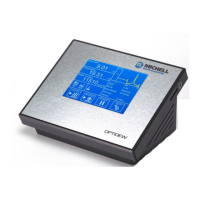Optidew User’s Manual
30 97551 Issue 1, February 2018
OPERATION
4.2 Operating Guide
4.2.1 Description
Once the Optidew has been powered on and has carried out its’ initial DCC, it will
attempt to find the dew point. In order to measure the dew point a Chilled Mirror
hygrometer must control a thin film of condensed water or ice on the mirror.
To initially form the condensate layer the mirror must be cooled past the actual dew
or frost point. The control system will then gradually heat the mirror to reduce the
thickness of this condensate layer. It typically takes several heating/cooling cycles
until the instrument has achieved the optimal film thickness where evaporation and
condensation are occurring in equilibrium. This is the true dew/frost point of the sample.
After finding the true dew point, the control system will continue to maintain the film
thickness at a constant level. Any decrease in actual sample dew point will cause
evaporation from the condensate film to increase – reducing its thickness and causing
the control system to cool the mirror to compensate. Likewise if the dew point increases
then condensation on the mirror will increase, and the control system will heat to
compensate.
In extreme cases where the dew point decreases very abruptly, then the condensate will
be completely evaporated from the mirror. In these scenarios the system will ‘search’
for the dew point again by cooling, resulting in cooing past the dew point as described
above. A similar situation occurs when the dew point increases abruptly, however the
condensate film can be lost here by the control system heating to compensate and
exceeding the new dew point.
The ‘Dew Point’ parameter on the Main Screen is a direct measurement of mirror
temperature, and only represents the actual sample dew point when the ‘Sensor’ indicator
in the Operational Status Display indicates ‘Control’. As described above, ‘Control’ will be
maintained in gradually changing conditions, but step changes will cause the instrument
to revert to ‘Heating’ or ‘Cooling’ modes.
4.2.2 Operating Practice
There are two basic methods of measuring with the Optidew:
In-situ measurements are made by placing the sensor(s) inside the environment to be
measured.
Extractive measurements are made by installing the sensor into a block within a sample
handling system, and flowing the sample outside of the environment to be measured
through this system
Extractive measurements are recommended when the conditions in the environment
to be measured are not conducive to making reliable measurements with the product.
Examples of such conditional limitations are:
• Excessive flow rate
• Presence of particulates matter
• Presence of entrained liquids
• Excessive sample temperature
• Dew point is beyond depression capability at sample temperature

